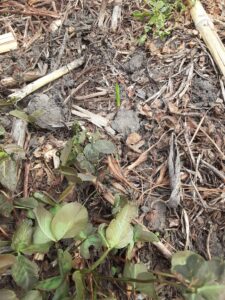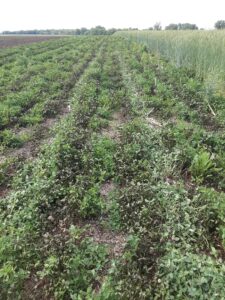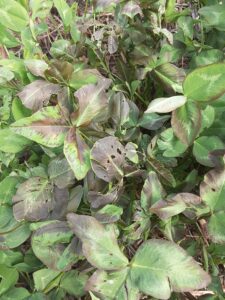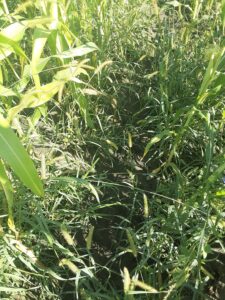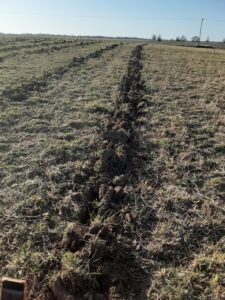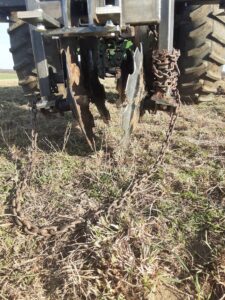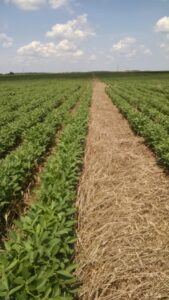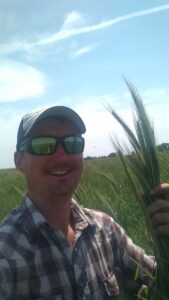Final report for ONC18-040
Project Information
Organic grain production is overly reliant upon soil disturbance and hand labor for weed control, undermining soil health and social justice benefits of organic agriculture. Our group of five organic grain growers currently practices rotational no-till, but wants to take advantage of residue management innovations to disturb even less soil. Over a two year period, on five Midwest organic farms (3 IL, 2 IN), we will evaluate the economic, environmental and labor performance of two organic grain production systems that maintain continuous living cover with different soil disturbance regimes. Both will follow a wheat-corn-soybean-fallow crop rotation. System 1, rotational no-till, will use primary tillage in the wheat and corn phases, but no-till plant soybean into crimped rye. System 2, nearly continuous no-till, will establish a white clover living mulch in wheat, seed fall-tilled strips in the clover with tillage radish for winterkill prior to no-till planting in the corn phase, and no-till soybean into crimped rye. Both systems will have a fallow phase with cool and warm season cover crops, to build soil and eliminate volunteer rye. We will conduct outreach through the IDEA Farm Network site both in real time, and at field days and annual meetings.
2019 was our first year to test our no till living cover system. Everyone was successful in raising a no till soybean and small grain crop. Volunteer cereal rye was a problem in both wheat and soybeans. It posed a marketing issue because the rye grain was difficult to separate from soybeans and impossible to separate from wheat. This was not an issued in the tilled fields. Every farm had a total loss in the corn phase of the living cover. The white clover was extremely competitive against the young corn seedlings, especially for moisture. The summer of 2019 was extremely dry and the shallow roots of the white clover prevented any rain fall from saturating past the top few inches. The corn in the tilled trial was poor but still harvest-able. This caused all of the other farmers except myself to drop out of the trial. It also made us consider a strip tillage system instead of a no till system. Mammoth red clover was also used instead of white dutch clover for 2020. On my farm in 2019, I tried using a high residue cultivator to kill the white clover. The HRC worked to kill the clover between the row but not in row and did not help with yield. A prototype "row mow" was used to set back some of the white clover on my farm and it was unsuccessful in setting back the white clover enough to have any effect on yield. The plots with white clover were almost void of any weeds, however the corn crop was a total loss.
2020 I was the only farmer participating in the trial and I decided to focus on finding a method to no till organic corn. I used mammoth red clover rather than white dutch clover because in previous years I have been able to kill the clover by mowing when it is starting to bud. The corn was no tilled in early June and mowed 10 days after planting. One small area was strip tilled. The anhydrous knife type bar that we used had trouble handling the amount of residue of the mammoth red clover and constantly plugged. After mowing approximately half of the clover regrew. Again, the summer of 2020 was dry and the corn suffered greatly from drought stress. The small area that was strip tilled did significantly better than the no till plot in growth and overall crop health, however all corn plots were a total loss. These plots was not cultivated or "row mowed". The plots were fairly clean with an acceptable amount of common row crop weeds. I do think that a healthy crop canopy could compete much better with weeds in the future. Along side the corn plot, I planted a small area of grain sorghum. Grain sorghum is a much more drought tolerant crop and proved to do much better no tilled into the mammoth red clover. I was hopeful that I would be able to harvest a crop until we experienced an early frost in September before the grain sorghum reached maturity. I am working with an independent machine shop to develop a strip till bar which can handle high amounts of residue with hope to plant corn on a tilled strip and then use a high residue cultivator to kill the in between row clover. 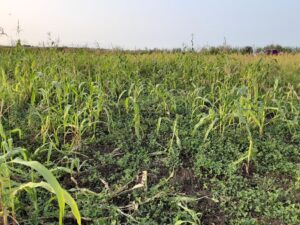
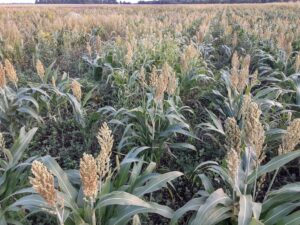
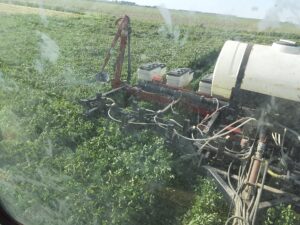
2021 Again the no till corn plot was a complete crop loss. Many practices were adjusted to give a final last effort to raise a successful no till corn crop. Fall of 2020 we trialed a strip till bar to attempt to kill some of the clover where we planned to plant corn rows the following spring but by May they had completely filled back in. Mammoth red clover was used again as the living cover crop and by planting time was a very thick and weed free stand. The corn was planted into good soil moisture and with good seed to soil contact on May 25. By June 2 the corn was spiking through the clover. I used a flame weeder to burn a strip over the emerging corn seedlings. This did a great job of setting back the red clover over the corn rows. The remaining clover between the rows was flail mowed on June 2 as well. June 5 I rotary hoed the plot. Half of the plot was cultivated at V4 corn with a Kinze high residue cultivator. The cultivator did help the corn grow taller but it never set a harvestable ear in either plots. Prior to entering this trial, I was very optimistic and confident that no till corn with a living cover could be a viable practice but I have not yet been able to raise a harvestable crop. In the past I have blamed bad weather for part of the failure but in 2021 we had excellent summer rainfall. I am not sure why the corn crop will not out compete the clover. The clover does die in mid summer and leaves a fairly clean field but it really stunts the corn growth.
On the other hand, the no till soybeans seem to be very successful. When cereal rye is planted by Sept 10 in central IL following a strong legume cover crop it grows thick enough to compete with a large portion of the weed populations. The cereal rye does seem to compete with the soybeans too and a yield drag is noticed when no till and tilled soybeans are planted at the same time. However, because of the excellent weed control from a massive cereal rye cover crop in a no till soybean field, I can plant soybeans in early May rather than early June and the earlier planting date seems to offset the yield drag. The no till soybean system that I have used successfully is to plant a clover cover crop into oats or wheat. After small grain harvest, allow the clover to grow until early September. In early September broadcast 3 bushels per acre of cereal rye into the clover and use a disk at least 2 times to terminate the clover and incorporate the rye. In mid April if I can walk the field and not see the soil through the rye canopy, I plant soybeans at 280,000 seeds per acre in 30" rows into the rye cover crop around May 5. The rye will be roughly in the boot stage. Later in May when the rye reaches pollen shed, I use a roller crimper to lay the rye flat and terminate. This leaves a weed suppressive barrier and holds a lot of moisture. Sometime, I need to use a late season high residue cultivator pass and/or a weed zapper to keep weeds from going to seed. This method saves time, yields similar to tilled systems and nearly eliminates surface erosion. In contrast, my tilled soybean practice is to plant 1 bushel of cereal rye after corn harvest between October and December depending on timing. Then to flail mow and disk 3x the rye a day or two prior to planting in early June. I still plant the soybeans at 280,000 seeds per acre and I use aggressive rowcleaners to make a trench. Then I rotary hoe the soybeans 3 days after planting if possible and again 3 days after the first rotary hoe pass. Then roughly 2 weeks after planting, I will use a multi sweep cultivator to cultivate the small soybeans and 6 weeks after planting I use a single sweep high residue cultivator for my lay by pass. This system works well when the weather cooperates but is very time intensive. Also after heavy rains, small rills form in the cultivated inter rows. And if the weather is wet and some of these critical steps are delayed, weeds can take hold and greatly decrease the soybean crop.
I have also had good success with no till cereal rye for harvest. Rather than disking down cultivated soybean fields and prepping a seed bed for planting cereal rye, it has become my standard practice to no till cereal rye right into freshly harvested soybean stubble. All of the warm season annuals die out with frost and the rye has always done very similar to when I was disking down the cultivator ridges. So now, I no till using a 750 John Deere drill. I drill cereal rye at 80lbs per acre as soon as I can after soybean harvest. The rye does a good job of out competing winter annuals in the early spring. I frost seed mammoth red clover in February into the growing rye. The one problem that I have with this is perennial weeds like Canada thistle. Canada thistle is a problem in nearly all of my small grain fields but does seem to be slightly worse in the no till rye fields.
Reducing tillage in organic production and utilizing living cover crop mulches is possible with some crops but not all. Small grains like rye do very well with a living cover crop of clover growing under the canopy after the grain crop is established. Soybeans do well planted early into a living cover crop, but the cover crop needs to be terminated before soybeans start aggressive vegetative growth. Corn is a crop that has does best with limited competition and full access to resources like fertility, sunlight and water. I plan to continue experimenting with different ways of raising no till organic corn but I do plan to shift some of my previous practices. Strip till corn and the use of a high residue cultivator seem to offer advantages but in my experiences we not enough to raise a harvestable corn crop. After the field day in 2021, 8 farmers expressed interested in learning more about how to adopt no till soybeans into their rotations and 12 were interested in trying no till rye. No one was interested in trying no till living cover corn.
- Establish two organic grain production systems with continuous living cover, but differing in soil disturbance intensity, on five Midwest organic farms (all crop rotation entry points present each year on each farm).
- Measure economic [grain yield, non-crop plant residue (cover crop and weed biomass), input costs and labor], environmental (water stable soil aggregates, fuel consumption), and social (hand labor for weeding) dimensions of sustainability in each experimental unit over two
- Host IDEA Farm Network field days and winter meetings to discuss and evaluate the performance of the different production
These were the original objectives. We have currently changed our objectives to see if we can grow a harvestable organic no till living cover corn crop. We are also hoping to develop a strip till bar which can handle high amounts of cover crop residue. We do not think that it is necessary to measure farm metrics if we cannot grow a harvestable crop.
No matter what we learn in 2021 we will be diligent in discussing our failures and successes with farmers through field days, meetings and Zoom presentations.
Objective 1) We were unable to established all phases of the crop rotation because we were not able to find a way to successfully raise no till living cover corn. All other phases of the rotation were established.
Objective 2) Attached in a spread sheet that compares the traditional organic tillage practice to the organic no till living cover practice. Soybeans and rye net returns were slightly reduced in the no till practice but the corn phase was greatly reduced bringing the whole average down. Outside of economics, weed control was worse in the no till practice but not as bad as it can be in wet years under the tillage practice. Visible life was more present in the no till practice (voles, rabbits, pheasants, spiders, earth worms, beetles, soil invertebrates). The mulches created by the living and dead cover crops did greatly reduce the amount of soil erosion and kept the soil moister through some of the dry spells experienced during the three growing seasons. Overall work load was also greatly reduced in the no till practice.
Objective 3) In 2021 we hosted an IDEA Farm Network field day in September where we walked and evaluated the no till plots. There was a lot of optimism around the no till soybeans. The rye was already harvested so no one could see it. In contrast, there was a lot of talk about the pitfalls of no till corn and discussion on how to adjust for future experiments. In 2019 and 2020 I hosted a number of individual farmer walks through the field and showed them the different phases of the rotation.
Cooperators
- (Researcher)
- (Researcher)
- (Researcher)
- (Researcher)
Research
This project will be a 3 crop and 4 year rotation of corn, soybeans, ley (cover crop fallow) and small grain. All crops will be grown all 3 years of this project. The goal of this project is to maintain a continuous living mulch through the entire rotation to assist in weed management and soil fertility under continuous no-till management in an organic cropping system. This will be compared to the same rotation but with limited tillage.
In the no-till rotation corn will be planted into a mowed stand of white clover. We think that by mowing before planting corn we can kill some early emerging weeds and start a decomposition process which will provide nutrients to the corn. We also plan to plant high populations of corn in order to shade the clover and encourage leaf senescence. A hydrolic powered mowing cultivator will be used to control inter row weeds. This mowing cultivator will be a hydraulic motor mounted to a shaft which powers disk mower knives. Following corn harvest, cereal rye will be no-till drilled at the farmers normal rate for no-till soybeans using the roller crimper method. Soybeans will be no-till planted into the cereal rye cover crop using the roller crimper method and the mowing cultivaor can be used if needed to control inter-row weeds. A ley (cover crop fallow) will be utilized as a method of controlling volunteer cereal rye after roller crimped soybeans and for weed control. Fast growing cover crops will be used based on farmer preference. The ley will be mowed or grazed as often as necessary for weed control. Small grains will be no-till planted into the residue of the ley. Depending on the farmer choice of cover crop, it may be necessary to mow the ley or it may winter kill. White clover will be frost seeded into the small grain and mowed or grazed if needed after small grain harvest to control weeds.
In the tillage comparison, the white clover will be tilled up according to the farmer preference prior to planting corn. The ley will also be tilled up according to the farmer preference prior to planting small grains. The soybeans will still be no-tilled using the roller crimper method and the ley will be no-till planted with cover crops.
This idea came about based on the success of the roller crimper method of no-till planting soybean and the research being conducted at the University of Georgia with no-till planting corn into white clover.
Some methods have changed. We are now using mammoth red clover instead of white dutch clover. The rotation has changed as well. Small grains are being planted after corn (oats or rye) and cover crop rye for crimping is planted in early September after a small grain crop.
Currently we are just beginning out trial. It took a year in advance to establish the white clover.
So far, no till corn has resulted in an unharvestable crop compared to tilled corn as a normal harvest. No till soybeans have been successful when the cereal rye cover crop is planted in September following a small grain crop of oats or rye. No till small grains has been successful following corn in the fall with cereal rye and on frozen stalk ground with oats. No till small grains seem to yield slightly less and have less weed pressure than tilled small grains. Soybeans yields are similar in no till and tilled when weed biomass is the same. High levels of giant foxtail greatly effect soybean yield.
Educational & Outreach Activities
Participation Summary:
Private farmer field walks were the primary form of outreach used. A field day was held in 2021. Multiple discussions were hosted on the IDEA Network and OGRAIN Listserv's.
Learning Outcomes
So far the farmer cooperator we are working with have begun to open their minds on the possibility of continuous no till organic farming. All of the farmers have had success with no till soybeans and would like to expand that for the rest of their operations. The farmers have also started looking into different types of clover or legumes to try to find something that can supply both adequate weed control and fertility.
Project Outcomes
This project has gained a lot of interest from farmers and we are anxious to see how well the crops grow this year.
Because of the poor results in no till corn, farmers have become more cautious with this phase of the rotation. Our success with no till soybeans and small grains has gained interest and we are working on way to fine tune these methods.
